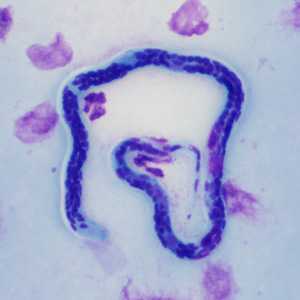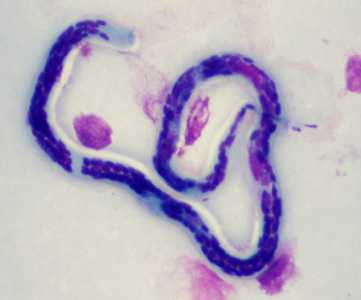
Case #347 - May, 2013
Random night blood specimens were collected from over 500 subjects in an area endemic for lymphatic filariasis in coastal India. Roughly one-third of the cases were symptomatic, with or without recurrent episodes of fever and various degrees of lymphedema. The objects in Figures A and B were observed on Giemsa-stained thick blood films from several of the asymptomatic cases. The objects measured on average 220 micrometers in length. What is your diagnosis? Based on what criteria?

Figure A

Figure B
Case Answer
This was a case of lymphatic filariasis caused by Brugia malayi. Diagnostic morphologic features included:
- sheathed microfilaria within the size range for B. malayi.
- dense nuclear column in which individual nuclei are easily defined.
- microfilariae with a relatively long head space and a tail with terminal and subterminal nuclei.
More on: Lymphatic Filariasis
Images presented in the monthly case studies are from specimens submitted for diagnosis or archiving. On rare occasions, clinical histories given may be partly fictitious.
DPDx is an education resource designed for health professionals and laboratory scientists. For an overview including prevention and control visit www.cdc.gov/parasites/.
- Page last reviewed: August 24, 2016
- Page last updated: August 24, 2016
- Content source:
- Global Health – Division of Parasitic Diseases and Malaria
- Notice: Linking to a non-federal site does not constitute an endorsement by HHS, CDC or any of its employees of the sponsors or the information and products presented on the site.
- Maintained By:


 ShareCompartir
ShareCompartir